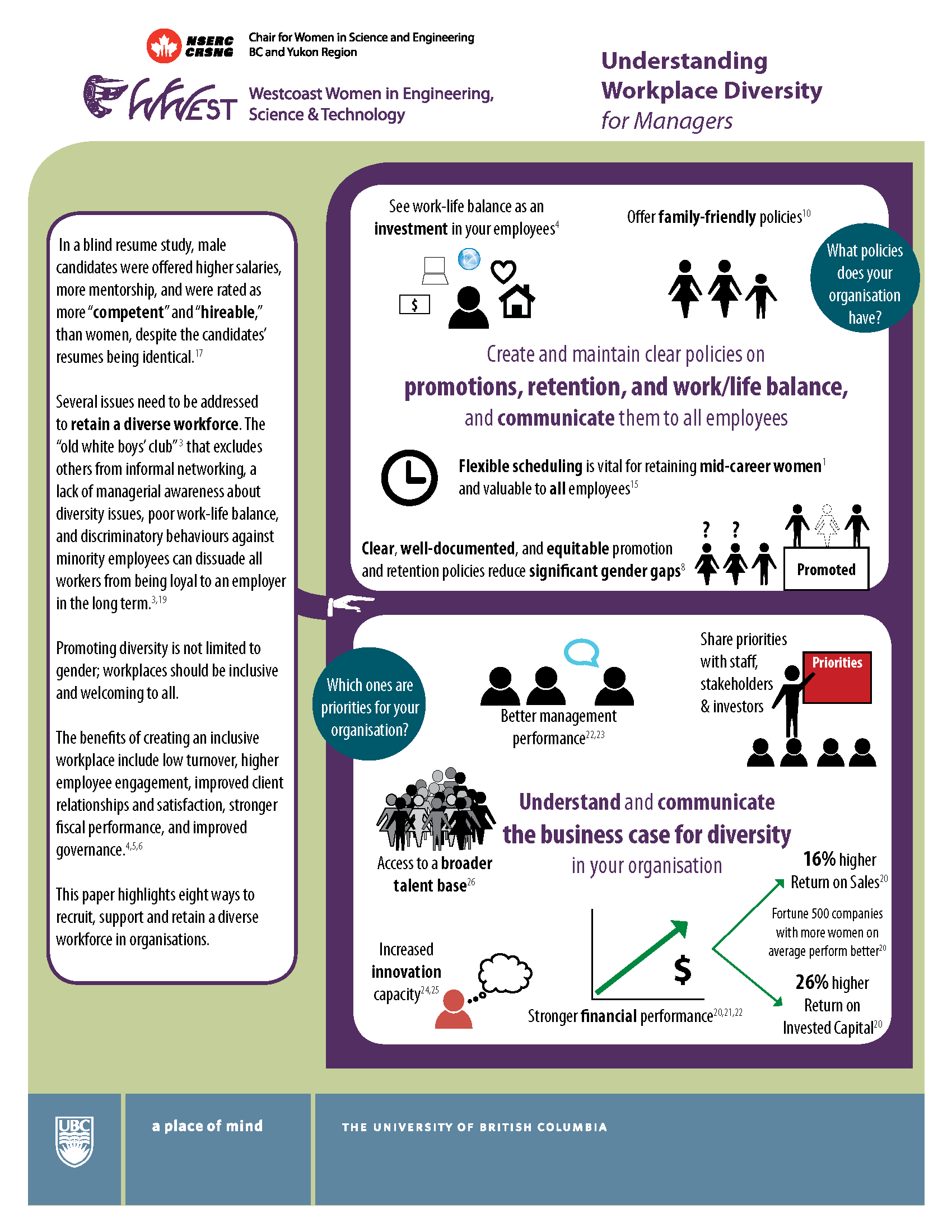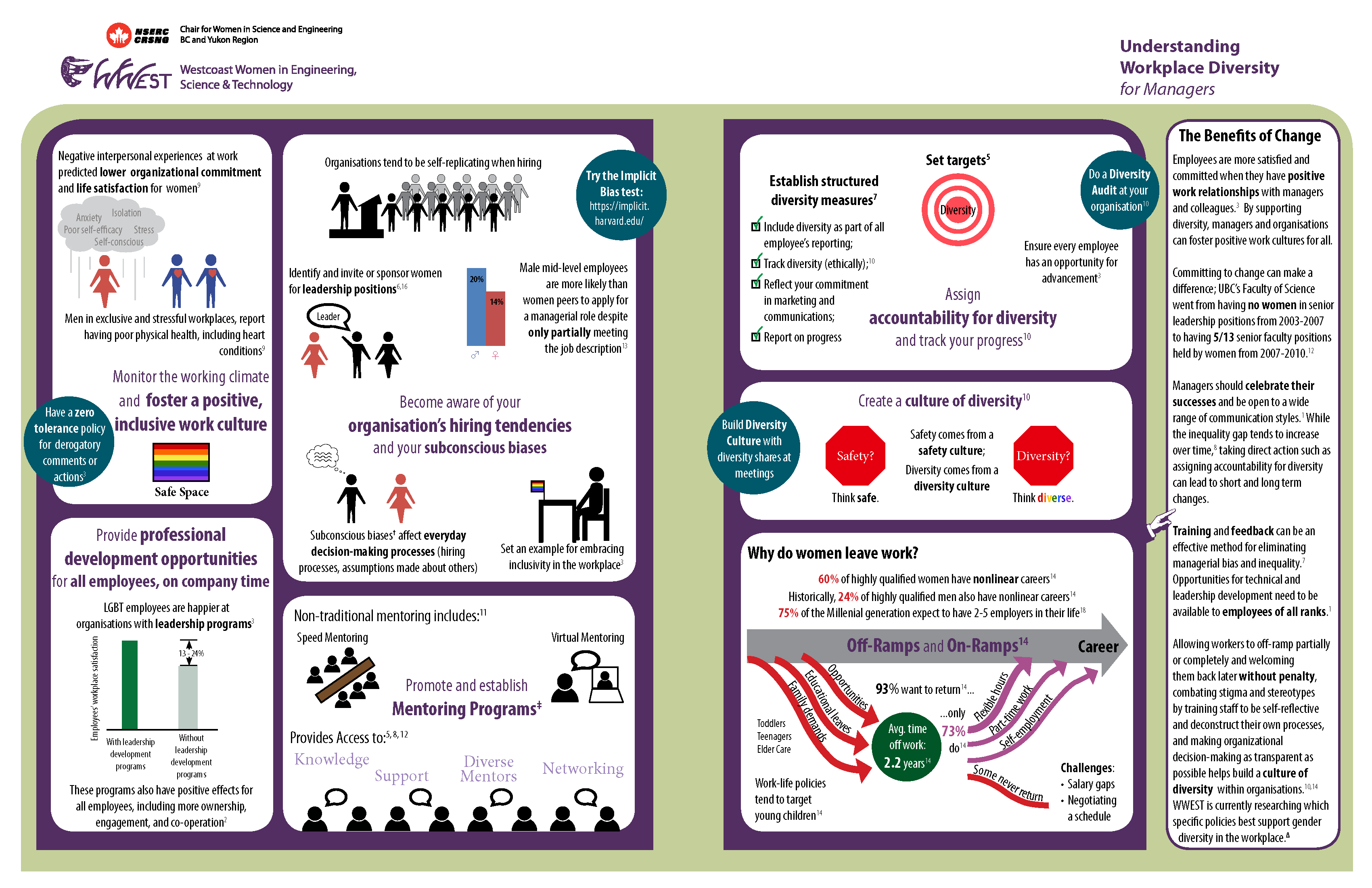Understanding Workplace Diversity – for Managers
In a blind resume study, male candidates were offered higher salaries, more mentorship, and were rated as more “competent” and “hireable,” than women, despite the candidates’ resumes being identical.17
Several issues need to be addressed to retain a diverse workforce. The “old white boys’ club”3 that excludes others from informal networking, a lack of managerial awareness about diversity issues, poor work-life balance,and discriminatory behaviours against minority employees can dissuade all workers from being loyal to an employer in the long term.3,19
Promoting diversity is not limited to gender; workplaces should be inclusive and welcoming to all. The benefits of creating an inclusive workplace include low turnover, higher employee engagement, improved client relationships and satisfaction, stronger fiscal performance, and improved governance.4,5,6
This paper highlights eight ways to recruit, support and retain a diverse workforce in organisations.
The Benefits of Change
Employees are more satisfied and committed when they have positive work relationships with managers and colleagues.3 By supporting diversity, managers and organisations can foster positive work cultures for all.
Committing to change can make a difference; UBC’s Faculty of Science went from having no women in senior leadership positions from 2003-2007 to having 5/13 senior faculty positions held by women from 2007-2010.12
Managers should celebrate their successes and be open to a wide range of communication styles.1 While the inequality gap tends to increase over time,8 taking direct action such as assigning accountability for diversity can lead to short and long term changes.
Training and feedback can be an effective method for eliminating managerial bias and inequality.7 Opportunities for technical and leadership development need to be available to employees of all ranks.1
Allowing workers to off-ramp partially or completely and welcoming them back later without penalty, combating stigma and stereotypes by training staff to be self-reflective and deconstruct their own processes, and making organizational decision‑making as transparent as possible helps build a culture of diversity within organisations.10,14
WWEST is currently researching which specific policies best support gender diversity in the workplace.
References
1. Simard, C., Henderson, A., Gilmartin, S., Shiebinger, L. & Whitney, T. (2008). Climbing the technical ladder: Obstacles and solutions for mid-level women in technology. Anita Borg Institute and Clayman Institute
for Gender Research. Retrieved from: http://anitaborg.org/files/Climbing_the_Technical_Ladder.pdf
2. Politt, D. (2012). Leadership programme brings big benefits for Raytheon. Training & Management Development Methods, 26(5), 5109-5114.
3. Silva, C. & Warren, A. (2009). Building LGBT-inclusive workplaces: Engaging organizations and individuals in change. Retrieved from: http://www.catalyst.org/knowledge/building-lgbt-inclusive-workplaces-engaging-organizations-and-individuals-change
4. Emerson, C., Williams, F., & Sherk. S. (2000). Best practices for the retention of women engineers and scientists in the oil and gas sector. New Frontiers, New Traditions National Conference for the Advancement
of Women in Engineering, Science & Technology. Retrieved from: http://www.mun.ca/cwse/BestPractices.pdf
5. Society for Human Resource Management. (2009). Global diversity and inclusion: perceptions, practices and attitudes. Retrieved from: http://www.shrm.org/
6. Mattis, M. (2001). Advancing women in business organizations: Key leadership roles and behaviors of senior leaders and middle managers. Journal of Management Development, 20(4), 371-388.
7. Kalev, A., Dobbin, F., & Kelly, E. (2006). Best practices or best guesses? Assessing the efficacy of corporate affirmative action and diversity policies. American Sociological Review, 71(4),589-617.
8. Kuske, R., Croft, E., Condon, A., Heckman, N, Hibsch-Jetter, C., Ingram, G., Maddison, W., McKenna, J., & van de Panne, Michiel. (2007). An assessment of the working climate for science faculty at UBC. Retrieved
from: http://science.ubc.ca/faculty/diversity
9. Hall, W., Schmader, T., & Croft, E. (2013). Engineering equality: How negative interactions undermine the health and well-being of male and female engineers. Paper presented at Society for Personality and Social
Psychology Annual Meeting, New Orleans, LA, USA.
10. Cukier, W., Smarz, S. & Yap, M. (2012). Using the diversity audit tool to assess the status of women in the Canadian financial services sector. The International Journal of Diversity in Organisations, Communities
and Nations, 11(3), 15-36.
11. APEGBC Women in Engineering and Geoscience Task Force. (2013). Women in engineering and geoscience task force report. Retrieved from: http://www.apeg.bc.ca/about/wiegtf.html
12. Condon, A., Hibsch-Jetter, C., Parrish, K. & Peacock, S. (2011). Equity and working climate initiative and outcomes pertaining to tenure-track at science: 2007-2010.
Retrieved from: http://science.ubc.ca/faculty/diversity
13. Institute of Leadership & Management. (2011). Ambition and gender at work. Retrieved from: http://www.i-l-m.com/Why-ILM/Research-reports/Ambition-and-gender
14. Hewlett, S.A. (2007). Off-ramps and on-ramps. Boston, MA: Harvard Business School Press.
15. Servon, L.J., & Visser, M.A. (2011). Progress hindered: the retention and advancement of women in science, engineering and technology careers. Human Resrouce Management Journal, 21(3), 272-284.
16. Davey, K. M. (2008). Women’s accounts of organizational politics as a gendering process. Gender, Work & Organization, 15, 650–671.
17. Moss-Racusin, C. et al. (2012). Science faculty’s subtle gender biases favor male students. Proceedings of the National Academy of Sciences of the United States of America, 109(41), 16474-16479.
18. PriceWaterhouseCoopers. (2008). Millennial at work: Perspectives from a new generation. Retrieved from: http://www.pointconsultinggroup.com/?portfolio=managing-tomorrow%E2%80%99-people
19. Ghosh, P., Satyawadi, R., Joshi, J.P., & Shadman, M. (2013) Who stays with you? Factors predicting employees’ intention to stay. International Journal of Organizational Analysis, 21(3), 288-312.
20. Catalyst. (2011). The bottom line: Corporate performance and women’s representation on boards (2004-2008). Retrieved from: http://www.catalyst.org/knowledge/bottom-line-corporate-performance-and-womens-representation-boards-20042008
21. Adler, R. D. (1999). Women in the executive suite correlate to high profits. For European Project on Equal Pay. Retrieved from: http://www.w2t.se/se/filer/adler_web.pdf
22. Brown, D. A. A., Brown, D.L. & Anastasopoulos, V. (2002). Women on boards: Not just the right thing… But the “bright” thing. The Conference Board of Canada. Retrieved from: http://www.conferenceboard.ca/
23. Orser, B. (2000). Creating high-performance organizations: Leveraging women’s leadership. The Conference Board of Canada. Retrieved from: http://www.conferenceboard.ca/
24. Torchia, M., Calabrò, A., & Huse, M. (2011). Women directors on corporate boards: From tokenism to critical mass. Journal of Business Ethics, 102(2), 299-317.
25. Woolley, A., Malone, T. & Berinato, (2011). What makes a team smarter? More women. Harvard Business Review, 89(6), 32-33. Retrieved from: http://hbr.org/2011/06/defend-your-research-what-makes-a-team-smarter-more-women/ar/1
26. Mannix, E., & Neale. M.A. (2005). What differences make a difference? The promise and reality of diverse teams in organizations. Psychological Science in the Public Interest. 6(2), 31-55.
Recommended Readings
1. Babcock, L. & Laschever, S. (2003). Women don’t ask: Negotiation and the gender divide. Princeton, NJ: Princeton University Press.
2. Hewlett, S. A. (2010, June). Off-ramps and on-ramps revisited. Harvard Business Review. Retrieved from http://hbr.org/2010/06/off-ramps-and-on-ramps-revisited/ar/1
† WWEST. (2013). Unconscious Bias. Retrieved from: https://wwest.mech.ubc.ca/diversity/
‡ WWEST. (2013). Mentoring Works. Retrieved from: https://wwest.mech.ubc.ca/diversity/
Δ For more information, please see Engendering Engineering Success: https://wwest.mech.ubc.ca/ees/



